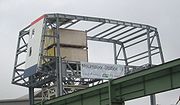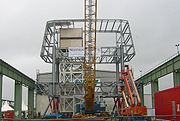
Neumayer-Station III
Encyclopedia
Neumayer-Station III, also known as Neumayer III after geophysicist Georg von Neumayer
, is a German South pole research station of the Alfred-Wegener-Institut
in the Antarctic
. It is located on the approximately 200-metre thick Ekstrom Ice Shelf
several kilometres south of Neumayer-Station II. The station's assembly kit was transported to its current position beginning of November 2007. It is moving with the shelf ice at about 200 meters per year towards the open sea.
After almost 10 years of work on the project (beginning October 1999); including conception, environmental impact investigation, planning and construction phases, regular operation of the station began on 20 February 2009. The station replaces the Neumayer-Station II and the Georg-von-Neumayer-Station that preceded it. The expected lifespan of the station is 25 to 30 years and the entire project is estimated to cost 39 million Euro
s.

 The station was constructed 6 m (19.7 ft) above ground on a temporary two-level platform and now sits on 16 columns; each hydraulic column rests on a solid snow surface. A garage and further technical equipment are located within a snow cavern below snow level at the front of the station. The moving concrete supporting feet are powered by hydraulic machinery. Through an annual lifting procedure of 80 to 100 cm (31.5 to 39.4 in) it is expected to prevent new snow from causing the platform to sink.
The station was constructed 6 m (19.7 ft) above ground on a temporary two-level platform and now sits on 16 columns; each hydraulic column rests on a solid snow surface. A garage and further technical equipment are located within a snow cavern below snow level at the front of the station. The moving concrete supporting feet are powered by hydraulic machinery. Through an annual lifting procedure of 80 to 100 cm (31.5 to 39.4 in) it is expected to prevent new snow from causing the platform to sink.
The station will run all year round and includes 210 m² (2,260.4 sq ft) of laboratory surface, divided into 12 compartments; in total, double the area of previous stations. Within the 15 accommodation containers there is room for 40 occupants to sleep. All inner rooms of the platform are built as self-contained units, some of which have aligned connecting passages, depending on their size. The compartmentalized interior of the station is enclosed in titanium protective sheet metal as thin as paper, with insulating Polyurethane
supra foam. The “structure section” image shows the simulated Antarctic snow-rooted crane between green metal girders. All items shown later found themselves on Antarctic snows in the form of Neumayer III.
The above surface construction of Neumayer III is predominant in the Antarctic, seen at other new stations such as Amundsen-Scott South Pole Station
and the mostly privately financed Belgian Princess Elisabeth Base
.
by March 2009. For construction, a work crew of 90 specialists was necessary. By mid January 2009 exterior work on the station was completed, so that further improvements to the 99 interior containers could continue unaffected by the weather.
. In addition to the main research areas of meteorology
, geophysics
and atmospheric chemistry
, which have been studied on the stations since the 1980s
, infrasound
has been studied for 5 years and marine acoustics
since 2005.
Georg von Neumayer
Georg Balthazar von Neumayer , was a German polar explorer and scientist who conceived the idea of international cooperation for meteorology and scientific observation....
, is a German South pole research station of the Alfred-Wegener-Institut
Alfred Wegener Institute for Polar and Marine Research
The Alfred Wegener Institute of Polar and Marine Research is a scientific organization located in Bremerhaven, Germany. The institute was founded in 1980 and is named after revolutionary meteorologist climatologist, and geologist Alfred Wegener...
in the Antarctic
Antarctic
The Antarctic is the region around the Earth's South Pole, opposite the Arctic region around the North Pole. The Antarctic comprises the continent of Antarctica and the ice shelves, waters and island territories in the Southern Ocean situated south of the Antarctic Convergence...
. It is located on the approximately 200-metre thick Ekstrom Ice Shelf
Ekstrom Ice Shelf
Ekström Ice Shelf is the ice shelf lying between Sorasen Ridge and Halvfarryggen Ridge, on Princess Martha Coast of Queen Maud Land. It occupies an area of 8,700 km²...
several kilometres south of Neumayer-Station II. The station's assembly kit was transported to its current position beginning of November 2007. It is moving with the shelf ice at about 200 meters per year towards the open sea.
After almost 10 years of work on the project (beginning October 1999); including conception, environmental impact investigation, planning and construction phases, regular operation of the station began on 20 February 2009. The station replaces the Neumayer-Station II and the Georg-von-Neumayer-Station that preceded it. The expected lifespan of the station is 25 to 30 years and the entire project is estimated to cost 39 million Euro
Euro
The euro is the official currency of the eurozone: 17 of the 27 member states of the European Union. It is also the currency used by the Institutions of the European Union. The eurozone consists of Austria, Belgium, Cyprus, Estonia, Finland, France, Germany, Greece, Ireland, Italy, Luxembourg,...
s.
Construction phase


The station will run all year round and includes 210 m² (2,260.4 sq ft) of laboratory surface, divided into 12 compartments; in total, double the area of previous stations. Within the 15 accommodation containers there is room for 40 occupants to sleep. All inner rooms of the platform are built as self-contained units, some of which have aligned connecting passages, depending on their size. The compartmentalized interior of the station is enclosed in titanium protective sheet metal as thin as paper, with insulating Polyurethane
Polyurethane
A polyurethane is any polymer composed of a chain of organic units joined by carbamate links. Polyurethane polymers are formed through step-growth polymerization, by reacting a monomer with another monomer in the presence of a catalyst.Polyurethanes are...
supra foam. The “structure section” image shows the simulated Antarctic snow-rooted crane between green metal girders. All items shown later found themselves on Antarctic snows in the form of Neumayer III.
The above surface construction of Neumayer III is predominant in the Antarctic, seen at other new stations such as Amundsen-Scott South Pole Station
Amundsen-Scott South Pole Station
The Amundsen–Scott South Pole Station is the American scientific research station on the high plateau of Antarctica. This station is located at the southernmost place on the Earth, the Geographic South Pole, at an elevation of 2,835 meters above sea level.The original Amundsen-Scott Station was...
and the mostly privately financed Belgian Princess Elisabeth Base
Princess Elisabeth Base
Princess Elisabeth Base, located on Utsteinen Nunatak in Dronning Maud Land is a Belgian polar station, taken into use on February 15, 2009. The station is the first polar base that combines eco-friendly construction materials, clean and efficient energy use, optimization of the station's energy...
.
Assembly
The majority of the construction materials and the heavy steel frame were delivered ending January 2008; plan dictates last construction equipment had to leave Ekstrom Ice ShelfEkstrom Ice Shelf
Ekström Ice Shelf is the ice shelf lying between Sorasen Ridge and Halvfarryggen Ridge, on Princess Martha Coast of Queen Maud Land. It occupies an area of 8,700 km²...
by March 2009. For construction, a work crew of 90 specialists was necessary. By mid January 2009 exterior work on the station was completed, so that further improvements to the 99 interior containers could continue unaffected by the weather.
Interior
In addition to the previously mentioned laboratories and accommodation areas, there is a south-facing lounge with many windows, a washing room containing two washing machines and two dryers, a Sauna, an IT-room, showering and washing rooms, a dining room with a serving window connected to the kitchen, a conference room, medical treatment and operating rooms, various storage rooms, a large refrigerating area, a dressing room, a heating-system room, a schooling and planning room and finally a water treatment room.Data
|
Enercon Enercon GmbH, based in Aurich, Germany, is the fourth-largest wind turbine manufacturer in the world and has been the market leader in Germany since the mid-nineties. Enercon has production facilities in Germany , Sweden, Brazil, India, Canada, Turkey and Portugal... wind generator: 30 kW |
Remote stations
At Neumayer-Station III, in order to minimize any affect that the main station's regular operations might have on the accuracy of scientific projects, small remote platforms are set up at a distance of 900 to 1500 m (2,952.8 to 4,921.3 ft) from the main station. Magnetic-, seismic-, trace element- and acoustic-research are the chief research foci of these remote stations.Research
Previous Neumayer stations have been the center of continuous research since 1981 especially with respect to their observatoriesObservatory
An observatory is a location used for observing terrestrial or celestial events. Astronomy, climatology/meteorology, geology, oceanography and volcanology are examples of disciplines for which observatories have been constructed...
. In addition to the main research areas of meteorology
Meteorology
Meteorology is the interdisciplinary scientific study of the atmosphere. Studies in the field stretch back millennia, though significant progress in meteorology did not occur until the 18th century. The 19th century saw breakthroughs occur after observing networks developed across several countries...
, geophysics
Geophysics
Geophysics is the physics of the Earth and its environment in space; also the study of the Earth using quantitative physical methods. The term geophysics sometimes refers only to the geological applications: Earth's shape; its gravitational and magnetic fields; its internal structure and...
and atmospheric chemistry
Atmospheric chemistry
Atmospheric chemistry is a branch of atmospheric science in which the chemistry of the Earth's atmosphere and that of other planets is studied. It is a multidisciplinary field of research and draws on environmental chemistry, physics, meteorology, computer modeling, oceanography, geology and...
, which have been studied on the stations since the 1980s
1980s
File:1980s decade montage.png|thumb|400px|From left, clockwise: The first Space Shuttle, Columbia, lifted off in 1981; American President Ronald Reagan and Soviet leader Mikhail Gorbachev eased tensions between the two superpowers, leading to the end of the Cold War; The Fall of the Berlin Wall in...
, infrasound
Infrasound
Infrasound is sound that is lower in frequency than 20 Hz or cycles per second, the "normal" limit of human hearing. Hearing becomes gradually less sensitive as frequency decreases, so for humans to perceive infrasound, the sound pressure must be sufficiently high...
has been studied for 5 years and marine acoustics
Acoustics
Acoustics is the interdisciplinary science that deals with the study of all mechanical waves in gases, liquids, and solids including vibration, sound, ultrasound and infrasound. A scientist who works in the field of acoustics is an acoustician while someone working in the field of acoustics...
since 2005.
External links
- Beschreibungsseite vom Alfred-Wegener-InstitutAlfred Wegener Institute for Polar and Marine ResearchThe Alfred Wegener Institute of Polar and Marine Research is a scientific organization located in Bremerhaven, Germany. The institute was founded in 1980 and is named after revolutionary meteorologist climatologist, and geologist Alfred Wegener...
- realnature.tv Video-, Foto-, und Textberichte über den Aufbau der Station in der Antarktis
- Video über die Station im Planet-Erde-Blog
- Animierte Infografik zur deutschen Antarktisstation Neumayer III, Tagesschau, 20. February 2009
- Neumayer III Station Webcam
- COMNAP Antarctic Facilities
- COMNAP Antarctic Facilities Map

